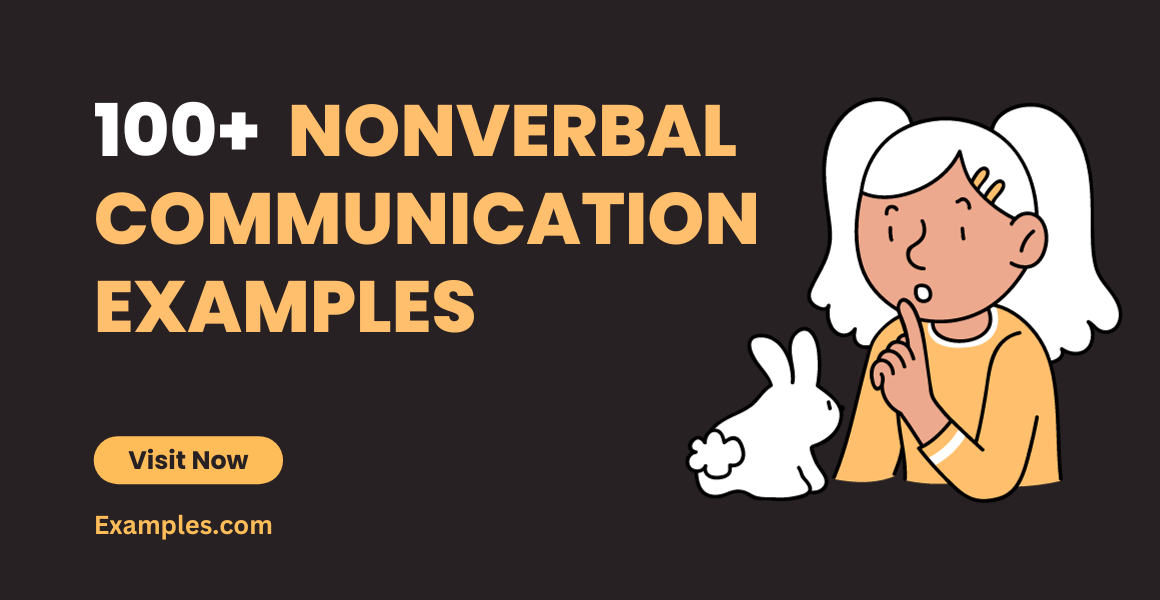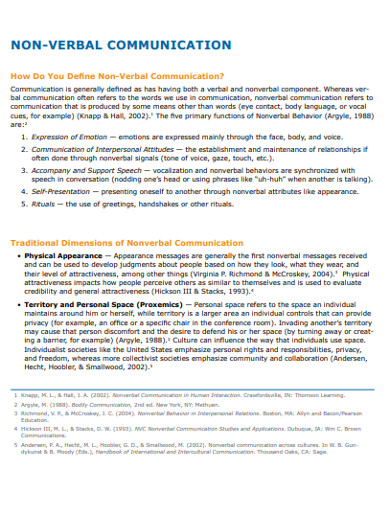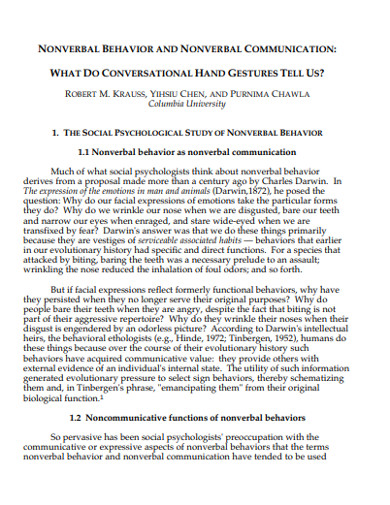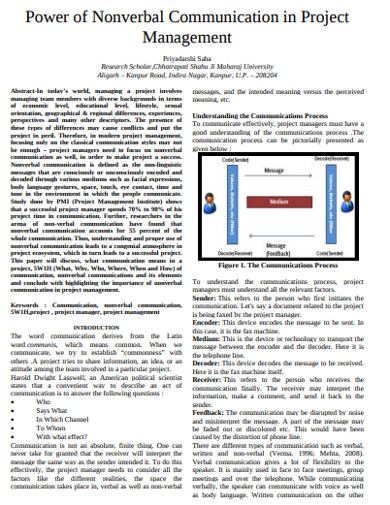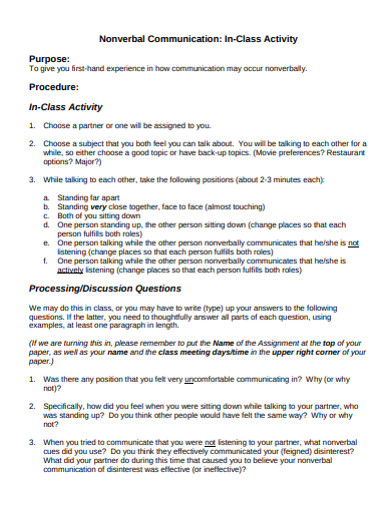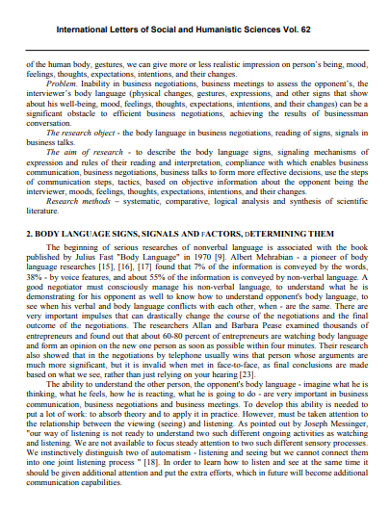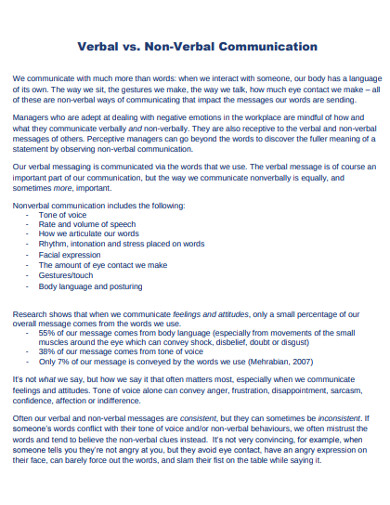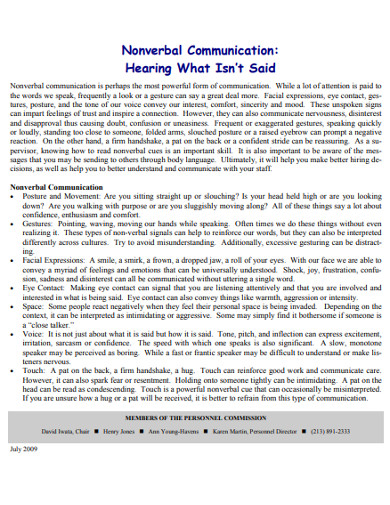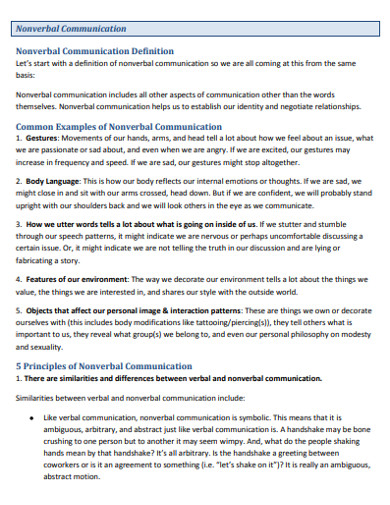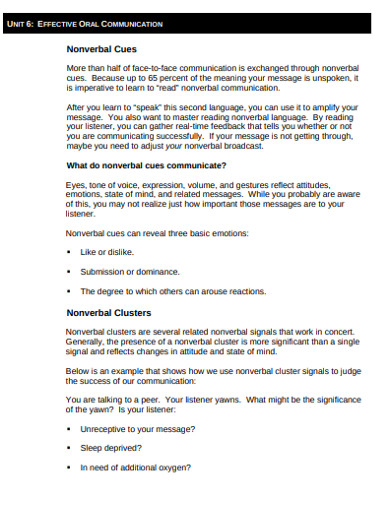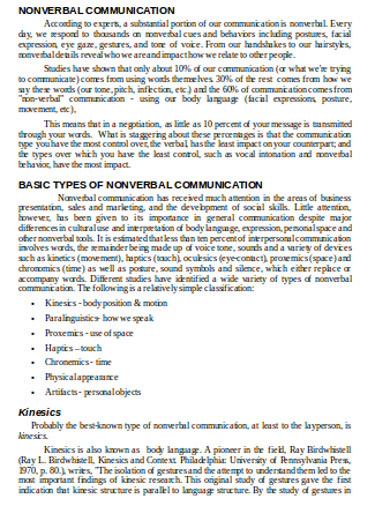100+ Nonverbal Communication Examples
Say “I disagree” as you make yourself as small as possible in your chair. Now, say it while you’re standing up with both hands on your hips. Which delivery would make you convincing? Which makes you feel powerful? Even without us noticing, our body language influences how others see us and how we see ourselves. In communication, our nonverbal linguistics is an essential part of our interaction with the world and with ourselves.
Speech is unique to humans. The rest of the world speak in the ruffling of feathers, coordinated dance routine, the fanfare of colors, and various vocalization, just to name a few. However, speech constitutes just a fraction of how we interact with others. Like animals, we speak through body language. In day-to-day interactions, nonverbal communication can sometimes convey more about what we say than the very thing we articulate. It is a non-linguistic manifestation of a message transmitted from a source to an audience. Even in silence, you are speaking loudly through the twitch and twinkle of your eyes, the curvature of your lips, the tone of your voice, your posture, even the rolls and waves you absent-mindedly make with your hands.
What is Nonverbal Communication? – Definition
Nonverbal communication is the process of sending and receiving messages without using words. This can include facial expressions, body movements, gestures, eye contact, posture, and even the tone and volume of a person’s voice. It’s like a silent form of communication that speaks volumes without uttering a single word. Nonverbal cues can convey feelings and intentions much more powerfully than spoken language at times.
What is the Best Example of Nonverbal Communication?
The best example of nonverbal communication is often found in a person’s facial expressions. A smile, for instance, universally signifies happiness or friendliness, while a frown can indicate sadness or disapproval. This is detailed in the way that even without saying anything, a person can communicate their emotions and reactions. For example, when someone receives a gift, their immediate smile can express gratitude and pleasure, often more genuinely than a simple “thank you” might convey. This smile, accompanied by bright eyes and a relaxed posture, can communicate a wealth of positive feelings.
100 Nonverbal Communication Examples
- Nodding: A universal sign of agreement or affirmation. 👍
- Shaking Head: Indicates disagreement or negation. 🙅♂️
- Eye Roll: Shows sarcasm, annoyance, or disbelief. 🙄
- Crossed Arms: Can be a sign of defensiveness or self-protection.
- Thumbs Up: A gesture of approval or that things are good. 👍
- High-Five: Indicates celebration or agreement. ✋
- Pat on the Back: A sign of approval or encouragement.
- Finger to Lips: Signals the need for silence or secrecy. 🤫
- Tapping Feet: Suggests impatience or anxiety.
- Leaning In: Shows interest and engagement in the conversation.
- Leaning Back: May indicate a relaxed attitude or disinterest.
- Steepling Fingers: Often a display of confidence or self-assuredness.
- Mirroring: When a person copies the posture of another, showing rapport.
- Furrowed Brow: Indicates worry, concentration, or confusion.
- Tilting Head: A sign of curiosity or contemplation.
- Waving Hand: Used to greet or say goodbye. 👋
- Pointing Finger: Directs attention or can be accusatory. 👉
- Slumped Shoulders: Suggests disappointment or sadness.
- Hands on Hips: Implies readiness or aggression.
- Rubbing Hands: Often a sign of anticipation or coldness.
- Standing Tall: Shows confidence or readiness.
- Avoiding Eye Contact: Can imply shyness, social anxiety, or dishonesty.
- Intense Eye Contact: Indicates focused attention or intimidation.
- Blinking Frequently: May signal discomfort or stress.
- Wrinkled Nose: Expresses disgust or distaste.
- Pursed Lips: Shows disapproval or skepticism.
- Playing with Hair: Can be a sign of flirting or boredom.
- Biting Nails: Indicates nervousness or stress.
- Open Palms: A gesture of openness, honesty, or submission.
- Thumb Display: Often seen as a sign of dominance or assertiveness.
- Handshake: A common greeting or agreement gesture. 🤝
- Fidgeting: Indicates restlessness or impatience.
- Sighing: Often a sign of relief or frustration.
- Hugging: Shows affection or comfort. 🤗
- Kissing: A sign of love or greeting. 😘
- Mocking: Imitating someone in a ridiculing manner.
- Saluting: A gesture of respect or acknowledgment. 🫡
- Covering Mouth: Can indicate shock or an attempt to suppress speech or reaction. 🤭
- Whistling: Often a sign of cheerfulness or to get someone’s attention.
- Snap of Fingers: Used to indicate a demand for quick action or attention.
- Clapping Hands: Shows appreciation or applause. 👏
- Yawning: Indicates tiredness or sometimes boredom. 🥱
- Stretching: Suggests a need for a break or relaxation.
- Giving the Middle Finger: A rude gesture of disrespect or anger. 🖕
- Peace Sign: Represents peace, victory, or a casual greeting. ✌️
- Shrugging Shoulders: Implies indifference or lack of knowledge. 🤷
- Hands in Pockets: May suggest casualness or an attempt to hide something.
- Drumming Fingers: Signals impatience or boredom.
- Adjusting Glasses: Can indicate a critical evaluation or deep focus on something.
- The ‘OK’ Sign: Expresses that all is well. 👌
- Squinting Eyes: Shows scrutiny or difficulty seeing.
- Lip Biting: A sign of anxiety or suppressed emotion.
- Head Shaking: Expresses disbelief or refusal. 🙅♂️
- Locked Ankles: May indicate discomfort or restraint.
- Quick Nods: Signify eagerness or agreement.
- Slow Nods: Demonstrate understanding or agreement at a relaxed pace.
- Foot Tapping: Suggests impatience or a rhythmic response to music.
- Palms Down: Can indicate authority or an attempt to calm down a situation.
- Hand Over Heart: Shows sincerity or solemn promise.
- Index Finger Over Mouth: Signals a demand for silence. 🤫
- Clenched Fists: Can be a display of anger, determination, or solidarity. ✊
- The ‘V’ for Victory: A sign of victory or peace. ✌️
- Cocking an Eyebrow: Indicates skepticism or interest.
- Rubbing the Chin: Suggests deep thought or judgment.
- Hands Clasped Behind Back: May denote confidence or contemplation.
- The ‘Come Here’ Gesture: Indicates a desire for someone to approach.
- The ‘Stop’ Hand: A universal sign to stop or stay away. ✋
- Winking: Implies playfulness or that one is joking. 😉
- Touching the Nose: May suggest secrecy or disbelief.
- Rubbing Eyes: Indicates tiredness or disbelief.
- Hands Clasped in Front: Often a sign of prayer, pleading, or patience.
- The ‘Thumbs Down’: Expresses disapproval or rejection. 👎
- Cupping Ear: Shows the need to hear better or that one can’t hear.
- Stroking Beard: Can indicate contemplation or judgment.
- Hands Shaking: A sign of excitement, agreement, or greeting. 🤝
- Raising One Eyebrow: Shows surprise or skepticism.
- The ‘Shaka’ Sign: Indicates a laid-back attitude or friendly gesture. 🤙
- Jazz Hands: Expresses excitement or enthusiasm.
- The ‘Time Out’ Sign: Requests a pause or break. 🤚
- Miming: Acting out actions without words, often in performance art.
- The ‘Heart’ Hand Gesture: Represents love or affection. 🫶
- The ‘Rock On’ Gesture: Signifies enjoyment, typically of music. 🤘
- The ‘Namaste’ Bow: A respectful greeting or farewell. 🙏
- The ‘Money’ Gesture: Indicates talking about money or wealth.
- Air Quotes: Used to indicate sarcasm or that what is being said should not be taken literally.
- The ‘Silent Clap’: A quiet acknowledgment or applause.
- The ‘Shush’ Gesture: Requests quiet or discretion. 🤫
- The ‘Phone’ Hand Gesture: Mimics a telephone for communication. 📞
- The ‘Write it Down’ Gesture: Indicates that something should be written down or remembered. ✍️
- The ‘I Don’t Know’ Shrug: Expresses uncertainty or lack of information. 🤷
- The ‘Watch’ Point: Indicates a question about time or a reminder of a schedule.
- The ‘Zipper Lip’: Suggests keeping information confidential. 🤐
- The ‘I’m Watching You’ Gesture: Indicates that one is being watched or scrutinized. 👀
- The ‘Talk to the Hand’: A dismissive gesture indicating one is not willing to listen. 🖐️
- The ‘Fish’ Story Hand Gesture: Implies that one is telling a story that might be an exaggeration.
- The ‘Live Long and Prosper’ Sign: A wish for good fortune and long life. 🖖
- The ‘Bow’: Shows deep respect or gratitude.
- The ‘Finger Gun’: A playful sign of acknowledgment or pretend threat.
- The ‘Balanced Hand’: Indicates weighing options or a balanced viewpoint.
- The ‘Facepalm’: Expresses frustration, embarrassment, or disbelief. 🤦
Nonverbal Communication Sentence Examples
Explore how unspoken cues enhance dialogue with our list of nonverbal communication sentence examples. From a reassuring pat on the back to an intense stare, each gesture adds depth to interactions without a word.
- Nodding While Listening: Demonstrates agreement or understanding during a conversation.
- Crossed Arms: Can signal defensiveness or a closed attitude in a debate.
- Leaning In: Shows interest and engagement when someone is speaking.
- Eye Rolling: Indicates disdain or frustration towards the speaker’s point.
- Handshake: A firm handshake conveys confidence and professionalism.
- Thumbs Up: Universally recognized as a sign of approval or success.
- High-Five: Represents celebration and agreement, often in team settings.
- Tapping Feet: Can show impatience or nervousness in a waiting scenario.
- Mirroring Posture: Reflects rapport and harmony between individuals in a discussion.
- Raised Eyebrows: Often expresses surprise or skepticism about information received.
Chronemics Examples
Chronemics, the study of time’s role in communication, is pivotal in understanding social interactions. Punctuality, response time, and time management speak volumes in various cultures.
- On-time Arrival: Respects the other party’s time, indicating professionalism.
- Protracted Silence: In negotiations, can be a power play or signal contemplation.
- Rapid Response to Emails: Shows eagerness and attentiveness in professional exchanges.
- Late Submission of Work: Suggests poor time management or disinterest.
- Taking Time to Listen: Reflects respect and care in personal relationships.
- Frequent Time Checks During a Meeting: May indicate boredom or urgency to leave.
- Extended Pauses in Speech: Used to emphasize points or control conversation flow.
- Scheduling at Convenience: Implies control over the timing and importance of an event.
- Time as a Gift: Spending quality time with someone can be a powerful expression of value.
- Chronological Storytelling: Shows the importance of timing and sequence in sharing experiences.
Nonverbal Communication Examples in Psychology
Nonverbal cues are a cornerstone in psychological analysis, revealing unspoken emotions and thoughts. They are critical in therapy, interviews, and research for understanding underlying messages.
- Facial Expressions in Therapy: Therapists assess clients’ emotions through their facial cues.
- Proxemics in Interviews: The physical distance maintained can reflect comfort levels or power dynamics.
- Gestures in Group Dynamics: Leaders often use hand gestures to direct attention or emphasize points.
- Posture in Confidence Studies: Upright posture is associated with high self-esteem in social psychology research.
- Touch in Developmental Psychology: The role of touch in bonding and attachment is extensively studied.
- Eye Contact in Social Anxiety Research: Avoidance of eye contact can be a sign of social anxiety.
- Paralinguistics in Personality Assessments: Tone and pitch variations can indicate personality traits.
- Facial Feedback Hypothesis: The expression of emotion can influence the emotional experience itself.
- Haptics in Healing: The therapeutic use of touch can communicate care and promote healing.
- Oculesics in Lie Detection: Eye movements are often analyzed to determine truthfulness.
Action Speaks Louder
Non-linguistic messages can make the right or wrong impression of you. You also unconsciously judge others based on how they are acting in front of you. Nonverbal communication influences how others perceive us.
Interpersonal Communication
In online chatrooms and chatboxes, emoticons can change how are messages are received by the recipient. However, things become so different when you are interacting with a real person in real life. You can’t hide behind the screen anymore. While it may not cause a problem when conversing with a long-time friend, not being aware of your nonverbal language may cost you that college scholarship, sales pitch, or project proposal.
In job interviews, for example, we can be so pre-occupied with nervousness and wanting to do things right that our body language reflects our uneasiness in the situation. Instead of projecting confidence and enthusiasm to our potential employers, we are hunching over and squirming in our seats. We are radiating this nervous energy, which can be distracting for the person interviewing us. Instead of showing them why they need us in their company, we rely on our words to convince them. That doesn’t usually end in our favor.
Intrapersonal Communication
Mind over matter. Can our bodies influence the psychology of the mind? Research says yes, and it has everything to do with your hormones. Leaders are said to possess high levels of testosterone and low levels of the stress hormone, cortisol. When the research participants were made to lead, their hormone levels followed such a pattern. This was observed with male participants because testosterone fluctuations aren’t as observable in women.
Another study investigated the influence of power posing on how a person would perform during a job interview. In a few minutes, such a small gesture delivered positive results. The ones that assumed a high power pose felt more confident, while the other end was more susceptible to stress.
The findings maintained that we can program our minds to think that we are more powerful than we normally think.
10+ Nonverbal Communication Examples in PDF
Practicing helpful nonverbal language during situations can help you and the people you interact with. While what you are saying is still important in what you say, how you present yourself whether you are talking or not is a nice addition.
1. Sample Nonverbal Communication Example
2. Basic Non Verbal Communication Example
3. Nonverbal Behavior Communication Example
4. Nonverbal Communication in Project Management Example
5. Nonverbal Class Activity Communication Example
6. Nonverbal Business Communication Example
7. Verbal and Non-Verbal Communication Example
8. Simple Nonverbal Communication Example
9. Formal Nonverbal Communication Example
10. Nonverbal Behavior of Technology Communication Example
11. Printable Nonverbal Communication Example
12. Non-Verbal Communication in DOC
Importance of Nonverbal Communication
Nonverbal communication is a key aspect of human interaction that goes beyond words. It encompasses all the ways we convey messages without speech, and its importance cannot be overstated. This silent language plays a crucial role in conveying emotions, intentions, and messages. It can affirm or contradict what’s being said, build trust and rapport, and provide feedback. It also helps to regulate the flow of communication and can be especially significant in cross-cultural contexts where language barriers exist. Understanding and mastering nonverbal cues can lead to more effective communication in personal, social, and professional settings.
Types of Nonverbal Communications
Nonverbal communication is diverse and multifaceted. Here are the primary types:
- Kinesics: This involves body movements, including gestures, facial expressions, and posture.
- Proxemics: The use of space and distance to convey messages.
- Haptics: Communication through touch, like a handshake or pat on the back.
- Oculesics: Eye behavior, such as eye contact, can indicate interest or aggression.
- Vocalics (Paralanguage): Vocal characteristics such as tone, pitch, and volume.
- Chronemics: The use of time as a communicative message, like punctuality or waiting time.
- Physical Appearance: Clothing and physical characteristics can also communicate nonverbal messages.
- Artifacts: Objects and visuals used to communicate messages, such as PowerPoint presentations or professional attire.
How do you write Nonverbal Communication? – Step by Step Guide
Writing nonverbal communication effectively requires a keen observation of human behavior and the ability to translate physical actions into written words. Here’s a step-by-step guide:
- Observe: Pay close attention to the nonverbal cues being displayed by individuals in various settings.
- Note the Context: Understand the situation where the nonverbal communication occurs, as context can drastically change the meaning.
- Describe the Behavior: Use vivid language to describe the nonverbal behavior. For instance, “She tilted her head slightly and squinted her eyes.”
- Interpret the Message: After describing the behavior, interpret what the action might mean, like “indicating skepticism or a critical thought process.”
- Reflect on Consistency: Consider whether the nonverbal behavior aligns with the verbal communication. If not, highlight the discrepancy.
- Use Metaphors and Similes: These can help readers visualize nonverbal cues. For example, “He stood immovable, like a statue, his silence speaking volumes.”
- Review and Revise: Ensure that the nonverbal communication you’ve written is clear, concise, and contributes to the overall message you’re conveying.
Tips for Using Nonverbal Communication
To use nonverbal communication effectively, consider these tips:
- Be Aware of Cultural Differences: Nonverbal cues can have different meanings in different cultures. Always be mindful of this in multicultural interactions.
- Align Nonverbal With Verbal: Ensure your body language matches what you’re saying to avoid confusion and convey sincerity.
- Practice Active Listening: Show that you are engaged in a conversation by nodding or maintaining appropriate eye contact.
- Use Gestures Sparingly: Overuse of gestures can be distracting. Use them to emphasize points, but do so judiciously.
- Monitor Your Tone: Your tone of voice can convey emotions and intentions, so be aware of how you sound, not just what you say.
- Be Conscious of Personal Space: Respect personal boundaries to avoid making others feel uncomfortable.
- Reflect and Adjust: Observe how others react to your nonverbal cues and be willing to adjust your behavior accordingly.
- Develop Empathy: Try to understand what others are feeling and respond appropriately with your nonverbal communication.
- Maintain Positive Eye Contact: Eye contact can convey confidence and interest, but be sure not to stare, as it can be perceived as aggressive.
- Learn from Feedback: Use the feedback you receive, both verbal and nonverbal, to improve your communication skills.
Speak Without Speaking
Another person’s impression of you before you open your mouth can influence your career and everyday life. Your self-esteem and how you value yourself is also visible in how you present yourself to the world. Verbal and nonverbal communication works together to deliver an effective message. Whether you are preparing for a speech or you just want to better yourself in interacting with others, improve your nonverbal communication with the following tips.
1. Become Aware
Before anything, you should pay attention to the things you’re doing unconsciously. You can ask your peers to point out things about you that you may be oblivious to. Look out for the actions or gestures you notice in others when they speak and consider the effect on you. Were you distracted? Compelled? You can also watch videos of speakers during TED talks or similar. Did the speakers captivate you to listen until the end? List down the things what not to do the next time.
2. Give Feedback
How unnerving would it be interviewed by someone barren of facial expression? When you are talking with someone, provide feedback through displaying the facial expression appropriate in the context of the conversation. Although this feedback manifestation in our nonverbal linguistics come naturally in most people, you might be one of the individuals who deliver their messages void of expression. Although it is not a grave fault, you might want to consider working on this part to train your communication skills.
3. Take Hints
Maybe the other person isn’t comfortable with physical contact or you are invading someone else’s personal space. It could be that the other person is not okay with the conversation. Take a break from your train of thoughts and notice the signs of discomfort the person is displaying. The signs may be too obvious, and you are just too into the topic to notice them. Ask if you are making them uncomfortable and make the necessary adjustments.
4. Vary Voice Tone
Whether for a formal speech or day-to-day conversation, there is a certain truth to “It is not what you said, it’s how you said it.” In relationships, the tone of your message can provoke quarrels. You may also be prone to misunderstand more the messages sent via text and chat since the message does not come with tone. Sarcasm is one of the things you cannot generally convey over the phone. Emojis are your best friend here. In face to face communication, the tone of your voice can change the context of the message. Therefore, you should be aware of the loudness, intonation, and timing of your words.


